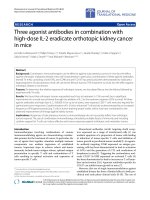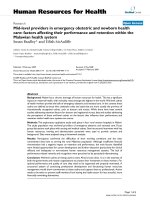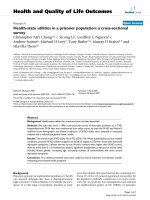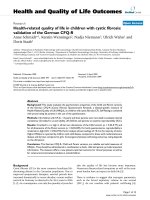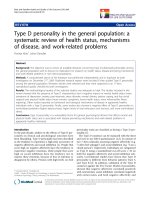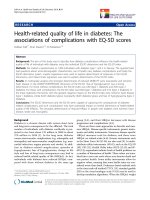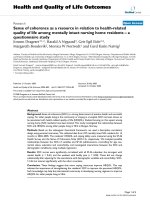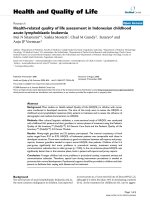báo cáo hóa học: " Health predicting factors in a general population over an eight-year period in subjects with and without chronic musculoskeletal pain" potx
Bạn đang xem bản rút gọn của tài liệu. Xem và tải ngay bản đầy đủ của tài liệu tại đây (464.96 KB, 9 trang )
BioMed Central
Page 1 of 9
(page number not for citation purposes)
Health and Quality of Life
Open Access
Research
Health predicting factors in a general population over an eight-year
period in subjects with and without chronic musculoskeletal pain
Susann Arvidsson*
1,2
, Barbro Arvidsson
3,4
, Bengt Fridlund
2,5
and
Stefan Bergman
1
Address:
1
Research and Development Centre, Spenshult hospital for rheumatic diseases, Oskarström, Sweden,
2
School of Health Sciences & Social
Work, Växjö University, Växjö, Sweden,
3
School of Social and Health Sciences, Halmstad University, Halmstad, Sweden,
4
Gjøvik University
College, Faculty of Nursing Science, Gjøvik, Norway and
5
School of Health Sciences, Jönköping University, Jönköping, Sweden
Email: Susann Arvidsson* - ; Barbro Arvidsson - ;
Bengt Fridlund - ; Stefan Bergman -
* Corresponding author
Abstract
Background: Many factors are proposed to be associated with health-related quality of life.
Knowledge of health factors associated to development of a good health-related quality of life could
be of use in clinical practice and public health work. The aim of this study was to investigate the
associations between suggested health factors and health-related quality of life at baseline and in an
eight-year follow up in subjects with and without chronic musculoskeletal pain in a cohort from a
general population.
Methods: The study was designed as a longitudinal study in a Swedish general population (N = 1
849) with a postal questionnaire at baseline 1995 and at follow up 2003. Subjects were divided into
two groups, according to their response about chronic musculoskeletal pain at baseline. Health-
related quality of life was assessed by the SF-36 together with suggested health factors. The
associations between SF-36 subscales and suggested health factors were estimated by OR and 95%
CI calculated by multivariable logistic regressions, with adjustment for all health factors, age, sex
and baseline SF-36 values.
Results: Although subjects without chronic musculoskeletal pain reported better health-related
quality of life than subjects with chronic pain, similar health factors were found to be associated to
higher scores in SF-36 at baseline and predicted a better outcome in the eight-year follow up. The
most consistent finding was a better health outcome in the eight-year follow up for subjects that
were feeling rested after sleep. Other factors that in some aspects predicted a better outcome
were belonging to higher socioeconomic group, being a native Swede, having emotional support,
having good sleep structure, never being or being a former smoker, and regularly drinking alcohol.
Conclusion: The most important health factor in subjects with and without chronic
musculoskeletal pain was feeling rested after sleep, but also emotional support, sleep structure,
smoking and alcoholic habits appears to be important components. These health factors could be
important to address in clinical work with painful musculoskeletal disorders. Since several health
factors are common in both subjects with and without pain there could be a common strategy to
be formed in public health programmes.
Published: 11 November 2008
Health and Quality of Life Outcomes 2008, 6:98 doi:10.1186/1477-7525-6-98
Received: 3 April 2008
Accepted: 11 November 2008
This article is available from: />© 2008 Arvidsson et al; licensee BioMed Central Ltd.
This is an Open Access article distributed under the terms of the Creative Commons Attribution License ( />),
which permits unrestricted use, distribution, and reproduction in any medium, provided the original work is properly cited.
Health and Quality of Life Outcomes 2008, 6:98 />Page 2 of 9
(page number not for citation purposes)
Background
There is an interest in health care and public health work
to identify different risk factors related to disease or ill
health in order to optimise prevention and early detection
of health problems and poor quality of life [1]. Knowl-
edge of risk factors as well as changes of attitude and life
style in the population is supposed to prevent or reduce
the burden of disease [2,3]. There has been a focus on pre-
vention and identification of disorders with high mortal-
ity, which misses the burden of common diseases, such as
musculoskeletal disorders [4,5]. Also in studies of muscu-
loskeletal disorders and health-related quality of life [6,7],
the priority has primarily been on risk factors (pathogen-
esis) instead of the patients' own capacity to adopt factors
that promote their health (salutogenesis) [2,3]. Studies
primarily looking at risk factors conclude that health
could be promoted by several factors, like having a good
social network and support, and good work environment
[8]. Physical activity is also important [9,10], together
with having a good diet [10], normal-weight [11] and
being satisfied with sleep [12]. It is also important to
reduce the use of alcohol [13] and tobacco [14,15].
Musculoskeletal disorders are major causes to morbidity
in the world, and these conditions have a strong negative
influence in terms of health-related quality of life [16]. In
Europe chronic musculoskeletal pain of moderate or
severe intensity occurs in 19% of the adults and these con-
ditions limits the daily activities to a high degree [17].
Musculoskeletal pain is a public health problem and a
common cause for people to seek for health care [18-20].
People with musculoskeletal pain, seeking for medical
help, estimate their quality of life lower than those who
do not seek for medical help [5]. It has also been shown
that people with musculoskeletal pain estimates their
health-related quality of life very low compared to a pain
free population, and that the perceived health can predict
musculoskeletal pain outcome [6,7,21].
In order to early identify and reduce the impact on health-
related quality of life from musculoskeletal disorders,
there is a need for more knowledge regarding factors asso-
ciated to a good outcome in health. This is of interest both
when meeting the patient in the clinical situation and in
the public health work aiming to reduce the impact of
musculoskeletal disorders in the population. Many factors
are proposed to be associated with the development of
health-related quality of life [8-15]. It is, from both health
promotional and clinical views, of interest to study if there
are different patterns of health factors in subjects with and
without a chronic condition, such as chronic muscu-
loskeletal pain. Knowledge of factors predicting good
health outcome could be used to optimise treatment strat-
egies and health factors common for subjects with and
without a musculoskeletal pain could be put forward in a
more general health promotion programme. There is a
lack of longitudinal studies on health-related quality of
life in subjects with or without chronic musculoskeletal
pain, focusing on factors that predict health-related qual-
ity of life instead of risk factors. The aim of this study was
to investigate the associations between suggested health
factors and health-related quality of life at baseline and in
an eight-year follow up in subjects with and without
chronic musculoskeletal pain in a cohort from a general
population.
Methods
Study design
The study was designed as a longitudinal study in a gen-
eral population with postal surveys at baseline and at an
eight-year follow up, and was a part of the Epipain project
[22].
Subjects and data collection
The target population was all 70 704 inhabitants aged 20–
74 years in two municipalities on the west coast of Swe-
den. In 1995 a sample of 3 928 subjects, representative for
the target population, was selected from the official com-
puterised population register. There were 2 425 subjects
(62%) who, after two postal reminders, gave their written
consent to participation and responded to the initial ques-
tionnaire, and 2 332 of those who responded were sent
the follow up questionnaire in 2003. Ninety-three sub-
jects were either deceased or had moved abroad. Out of
the 2 332 eligible subjects, and after two postal reminders,
there were 1 849 respondents (79%) at the follow up.
The 1 849 subjects were divided into two groups, accord-
ing to their response about chronic musculoskeletal pain.
At baseline there were 1 109 (60%) subjects without
chronic pain and 700 (38%) subjects with chronic pain.
There were missing data about pain for 40 (2%) subjects.
The Epipain questionnaire
The first part of the questionnaire used in the postal sur-
veys consisted of the well-established Short Form-36
Health Survey (SF-36) in its Swedish standard version
[23]. The Swedish version of SF-36 has been found to be
reliable and valid [24-26]. The SF-36 is a 36 item ques-
tionnaire that gives eight subscales assessing different
aspects of health-related quality of life: Physical Function-
ing (PF), Role – Physical (RP), Bodily Pain (BP), General
Health (GH), Vitality (VT), Social Functioning (SF), Role
– Emotional (RE) and Mental Health (MH). The score for
each of the eight subscales range from 0–100. A higher
score indicates better health in that aspect [23].
In the second part of the Epipain questionnaire [22], a
majority of the questions were taken from prior studies,
where the questions had been found useful. The face and
content validity have been found to be good in the second
part of the Epipain questionnaire. The reliability was
Health and Quality of Life Outcomes 2008, 6:98 />Page 3 of 9
(page number not for citation purposes)
tested with a test-retest and the kappa-value was found to
be ranged from 0.8 to 1.0 on the individual questions
[27]. The second part of the questionnaire had an overall
key question on chronic musculoskeletal pain experience:
Have you experienced pain lasting more than three months dur-
ing the last twelve months? It was explained in an introduc-
tion that the pain should be persistent or regularly
recurrent in the musculoskeletal system. The question-
naire also assessed factors that have been proposed by pre-
vious studies to influence the effect on health-related
quality of life, such as socioeconomic status, being immi-
grant, emotional support, regularly exercise, quality of
sleep, smoking and alcohol habits [8-10,13-15,22].Socioe-
conomic status was based on an open question regarding
the subject's occupation. Immigrant status was based on a
question regarding if the subjects themselves or at least
one of their parents were born in another country. Emo-
tional support was based on a question regarding if the sub-
jects have one or more persons who support them to cope
with distress and problems in life.Regularly exercise was
based on a question regarding if the subjects exercise reg-
ularly during the week [22]. Quality of sleep was based on
four questions regarding different aspects of sleep distur-
bances [22,28,29]. Smoking habits were based on a ques-
tion regarding if the subjects were smokers or not. Alcohol
habits were based on a question regarding how often the
subjects were drinking alcohol [22].
Statistical procedure and analyses
The subjects were divided into two groups, according to
their response about chronic musculoskeletal pain at
baseline. Subjects that could not be classified where
excluded from the analyses. Socioeconomic status was based
on the subject's occupation, and classified according to
the Swedish socioeconomic classification system, SEI
[30]. The 18 basic socioeconomic classes were merged to
four groups: manual workers, assistant no manual
employees, intermediate/higher no manual employees
including upper level executives, and others. The group
"others" included self-employed, farmers, housewives,
and students [22]. The question regarding emotional sup-
port could be answered with four alternatives; (1) Yes, def-
initely, (2) Yes, probably, (3) Not sure, and (4) No. The
alternatives 1–2 were dichotomised into Yes and 3–4 into
No. The quality of sleep was assessed by four questions.
Three of these questions were about falling asleep, fre-
quent awakenings during the night and early morning
awakening. These questions were regarded to assess the
structure or pattern of sleep, and were merged into one
group, sleep structure, in the analyses. The worst score in
any of the three questions was regarded as representative
for problems with sleep structure. The fourth question,
not feeling rested after sleep, was regarded to represents a
more qualitative aspect of non-restorative sleep and was
introduced separately in the analyses as feeling rested.
Sleep problems were assessed with five alternatives; (1)
No problems, (2) Small problems, (3) Some problems,
(4) Great problems, and (5) Very great problems. In the
analyses the answers were merged into two groups with
scores 1–2 representing no/small problems, and scores 3–
5 representing moderate/major problems. Alcohol habits
assessed the frequency of alcohol use with five alterna-
tives; (1) Never, (2) Very seldom, (3) Monthly, (4) 1 or 2
times a week, and (5) Daily. These were merged into three
categories with scores 1–2 representing never/rare, 3 rep-
resenting monthly, and 4–5 representing weekly.
The statistical analyses were done with the statistical pack-
age SPSS for Windows, release 15.0. T-test was used for
statistical comparison of means. Chi-square-test was used
for comparisons of prevalence between groups. The asso-
ciations between the dependent variables (SF-36 sub-
scales) and independent variables (i.e. the suggested
health factors; socioeconomic status, immigrant status,
emotional support, regularly exercise, sleep structure, feel-
ing rested, smoking and alcohol habits) were estimated by
odds ratios and their 95% confidence intervals calculated
by multivariable logistic regressions, with adjustment for
all health factors, age, sex and baseline SF-36 values. The
SF-36 scores were dichotomised with regard to the mean
values in the population for each subscale (1 ≥ mean and
0 < mean). The analyses were done with simple contrast
to a reference group for each of the independent variables.
At baseline the analyses were checked for interaction
between sex or age and all of the independent variables.
Subjects with missing values for any of the variables were
rejected from the analyses. The actual number of subjects
in each analysis is reported in Additional files 1 and 2
(Tables 1–4), and was considered to fulfil the requirement
of at least 10 subjects in the outcome for each independ-
ent variable. A P-value of less than 0.05 was considered
statistically significant.
Ethics
The study was approved by the Ethics Research Commit-
tee, Faculty of Medicine, Lund University, Sweden. The
Swedish Data Inspection Board approved the computer-
ised registration.
Results
There was a predominance of women (61% women vs.
39% men; P < 0.001) at baseline in subjects with chronic
musculoskeletal pain, and a small statistically significant
difference for subjects without chronic pain (52% women
vs. 48% men; P < 0.001). Subjects with chronic pain were
significantly older than those without chronic pain (mean
age 50.3 vs. 44.6; P < 0.001). Details regarding the distri-
bution of sociodemographic characteristics and suggested
health factors with regard to the two groups with and
without chronic musculoskeletal pain are found in Addi-
tional file 1 (Table 5).
Health and Quality of Life Outcomes 2008, 6:98 />Page 4 of 9
(page number not for citation purposes)
Health-related quality of life at baseline and at the eight-
year follow up
Subjects without chronic musculoskeletal pain scored sig-
nificantly (P < 0.001) better than subjects with chronic
musculoskeletal pain in all eight SF-36 dimensions both
at baseline and at the eight-year follow up (Figure 1). The
scores for all SF-36 dimensions significantly (P < 0.001)
deteriorated over the eight-year follow up for subjects
without chronic pain. The changes were more complex for
subjects with chronic pain; significant worsening for PF (P
< 0.001), SF (P = 0.004) and RE (P = 0.001), significant
improvement for BP (P = 0.004), and no significant
changes for RP (P = 0.368), GH (P = 0.419), VT (P =
0.391), and MH (P = 0.633).
Factors predicting health-related quality of life at baseline
and at the eight-year follow up
The association between suggested health factors and
baseline SF-36 mean scores, and the predictive value of
these health factors with regard to SF-36 development
over eight years, were estimated with multivariable logis-
tic regression analyses, controlling for sociodemographic
characteristics. Results from the multivariable logistic
regressions with odds ratios (OR) and 95% confidence
intervals (CI) for these variables are found in Additional
files 1 and 2 (Tables 1–4).
For subjects without chronic musculoskeletal pain at
baseline, male sex was significantly (P < 0.05) associated
with having a health status better than the mean score at
baseline in PF, VT, SF, RE, and MH, and a worse score in
RP. For those with chronic musculoskeletal pain, male sex
was significantly associated with having a health status
better than the mean score in PF. In the eight-year follow
up, male sex significantly predicted a better score only in
SF for subjects with chronic pain.
For subjects without chronic musculoskeletal pain at
baseline, younger age was significantly (P < 0.05) associ-
ated with having a health status better than the mean
The SF-36 scores for subjects with and without chronic musculoskeletal pain in 1995 and 2003Figure 1
The SF-36 scores for subjects with and without chronic musculoskeletal pain in 1995 and 2003. Comparison of
the SF-36 subscales scores (mean values) for subjects with and without chronic musculoskeletal pain at baseline in 1995 and at
follow up in 2003.
0
10
20
30
40
50
60
70
80
90
100
Physical
Functioning
Role-Physical Bodily Pain General
Health
Vitality Social
Functioning
Role-
Emotional
Mental Health
Me a n
Subjects without pain -95
Follow up -03, for subjects without pain -95
Subjects with pain -95
Follow up -03, for subjects with pain -95
Health and Quality of Life Outcomes 2008, 6:98 />Page 5 of 9
(page number not for citation purposes)
score in PF, RP, BP and GH. For those with chronic musc-
uloskeletal pain at baseline, younger age was significantly
associated with having a health status better than the
mean score for PF, RP, BP and GH. The same pattern could
be seen in the eight-year follow up, except that being in
the middle age groups significantly predicted better out-
come in SF and RE for subjects without chronic pain, and
in RE and MH for subjects with chronic pain.
For subjects without chronic musculoskeletal pain at
baseline, belonging to a higher socioeconomic status was
significantly (P < 0.05) associated with having a health
status better than the mean score in PF. For those with
chronic musculoskeletal pain, belonging to a higher soci-
oeconomic status was significantly associated with having
a health status better than the mean score in PF, RP, and
GH. In the eight-year follow up, a higher socioeconomic
status significantly predicted a better outcome in PF for
subjects with chronic pain.
For subjects without chronic musculoskeletal pain at
baseline, regarding immigrant status, being a native Swede
was significantly (P < 0.05) associated with having a
health status better than the mean score in PF, RP, GH, VT,
and MH. For those with chronic musculoskeletal pain,
being a native Swede was significantly associated with
having a health status better than the mean score in GH
and VT. In the eight-year follow up, being a native Swede
significantly predicted a better outcome in RE and MH
both for subjects with and without chronic pain.
For subjects without chronic musculoskeletal pain at
baseline, having emotional support was significantly (P <
0.05) associated with having a health status better than
the mean score in RP, GH, VT, SF, RE, and MH. For those
with chronic musculoskeletal pain at baseline, emotional
support was significantly associated with having a health
status better than the mean score in GH, VT, SF, RE, and
MH. In the eight-year follow up, emotional support sig-
nificantly predicted a better outcome in RP, VT, RE, and
MH in subjects with chronic pain, but was not signifi-
cantly predictive in subjects without chronic pain.
For subjects without chronic musculoskeletal pain at
baseline, exercise regularly was significantly (P < 0.05)
associated with having a health status better than the
mean score in PF, BP, and VT. For those with chronic mus-
culoskeletal pain at baseline, exercise regularly was not
significantly associated to any of the eight SF-36 health
concepts. In the eight-year follow up exercise regularly
failed to significantly predict any outcome in SF-36.
For subjects without chronic musculoskeletal pain at
baseline, a good sleep structure was significantly (P < 0.05)
associated with having a health status better than the
mean score in all eight SF-36 health concepts except RP.
For those with chronic musculoskeletal pain at baseline, a
good sleep structure was significantly associated with hav-
ing a health status better than the mean score in all eight
SF-36 health concepts. In the eight-year follow up a good
sleep structure significantly predicted a better outcome in
PF, RP, and BP for subjects without chronic pain, and in
GH and RE for subjects with chronic pain.
For subjects without chronic musculoskeletal pain at
baseline, feeling rested after sleep was significantly (P <
0.05) associated with having a health status better than
the mean score in all eight SF-36 health concepts except
BP. For those with chronic musculoskeletal pain at base-
line, feeling rested was significantly associated with hav-
ing a health status better than the mean score in all eight
SF-36 health concepts except PF. In the eight-year follow
up feeling rested significantly predicted a better outcome
in BP, GH, VT, SF, RE, and MH for subjects without
chronic pain, and in BP, VT, SF, RE, and MH for subjects
with chronic pain.
For subjects without chronic musculoskeletal pain at
baseline, and regarding smoking habits, never being a
smoker or being a former smoker, compared to being a
current smoker, was significantly (P < 0.05) associated
with having a health status better than the mean score in
PF and MH. For those with chronic musculoskeletal pain
at baseline, never being a smoker or being a former
smoker, was not significantly associated to any outcome
in SF-36. In the eight-year follow up, never being a smoker
or being a former smoker significantly predicted a better
outcome in GH, SF, and RE for subjects without chronic
pain, and in RE and MH for subjects with chronic pain.
For subjects without chronic musculoskeletal pain at
baseline, and regarding alcohol habits, drinking weekly,
compared to never or rarely, was significantly (P < 0.05)
associated with having a health status better than the
mean score in PF, RP, and GH. For those with chronic
musculoskeletal pain at baseline, weekly drinking of alco-
hol was significantly associated with having a health sta-
tus better than the mean score in BP and VT. In the eight-
year follow up weekly drinking of alcohol significantly
predicted a better outcome in RP and MH for subjects
without chronic pain, and in PF, RP, BP, and RE for sub-
jects with chronic pain.
Although the multivariable logistic regression analyses
were not intended to be complete explanatory models, at
baseline 8.2–32.7% (Nagelkerke R
2
) of the variance in the
dependent variables could be explained by the predictor
variables for subjects without chronic pain. The figures
were between 16.4–30.9% for subjects with chronic pain.
In the eight-year follow up it was 14.5–40.9% for subjects
without chronic pain and 26.3–49.5% for subjects with
chronic pain.
Health and Quality of Life Outcomes 2008, 6:98 />Page 6 of 9
(page number not for citation purposes)
Interactions
The analyses where checked for interactions between sex
and age, and the suggested health factors at baseline.
Although some interactions were noted, few were statisti-
cal significant, they were mostly inconsistent and not
affecting the main outcome. For subjects with chronic
musculoskeletal pain an analysis stratified on sex showed
that being a native Swede was associated to better health
outcome regarding RP in women but not in men (women:
OR 2.95, 95% CI 1.40–6.23; men: OR 0.52, 95% CI 0.20–
1.31). The same was noted for RE (women: OR 2.14, 95%
CI 1.10–4.15; men: OR 0.52, 95% CI 0.17–1.53). Analy-
ses on subjects with chronic musculoskeletal pain also
showed a significant interaction between sex and former
smokers in RP (women: OR 2.01, 95% CI 1.05–3.82;
men: OR 0.84, 95% CI 0.39–1.82,).
Exercise regularly in age stratified analyses were shown to
predict a positive outcome in all eight SF-36 domains for
those in the oldest age group but not in the younger age
groups for subjects with chronic pain.
Discussion
Although subjects without chronic musculoskeletal pain
reported better health-related quality of life as measured
by SF-36 than subjects with chronic musculoskeletal pain,
similar health factors were found to be associated to a
higher score in health at baseline and also predicted a bet-
ter outcome in an eight year follow up both in subjects
without and with chronic pain. The most consistent find-
ing was a better health outcome for subjects that at base-
line were feeling rested after sleep. Other factors that in
some aspects predicted a better outcome, controlled for
age and sex, were belonging to a higher socioeconomic
group, being a native Swede, having emotional support,
having a good sleep structure, never being or being a
former smoker, and regularly drinking alcohol.
Sociodemographic characteristics like being of male sex,
younger ages, belonging to a higher socioeconomic status
and being a native Swede were associated with having a
health status better than the mean score in many of SF-36
health concept at baseline for both subjects with and
without chronic musculoskeletal pain. It could be noted
that belonging to a younger age group was associated with
having a better health status at baseline in the more phys-
ical domains of SF-36 (PF, RP, BP, and GH), but not in the
more mental (VT, SF, RE, and MH) domains. The same
pattern could be seen in the eight year follow up. At the
follow up the sociodemographic characteristics, except
being of younger age, were of less importance. A study
from Texas also showed that being of younger age was
important when subjects estimated health but also higher
income [10]. The interaction analyses in the present study
showed that there could be a sex difference, especially
with respect to immigrant status, where being a native
Swede was a health factor for women, but not for men. A
study from Canada also showed that native-born females
reported better health status than foreign-born females
[31].
Emotional support was found to be important for a better
health-related quality of life at baseline, but at the follow
up emotional support was important only for subjects
with chronic musculoskeletal pain. Others have reported
that emotional support could be very important for the
possibilities to handle a disease such as rheumatoid
arthritis and its consequences [32]. This strengthens that
emotional support could be an important domain to
work with in health promoting work.
It was surprising to notice that exercise regularly not was
found to be important for health-related quality of life.
This is not in accordance with previous studies that have
shown a positive association between exercise and health
[9,10]. One explanation could be how the term exercise is
perceived in different age groups. It is not unlikely that the
younger subjects in the present study misunderstood the
question and did not count physical activity like walking
as exercise. The interaction analyses could be an indicator
of this, as physical exercise in age stratified analyses was
shown to predict a positive outcome in most SF-36
domains for those in the oldest age group but not in the
younger age groups for subjects with chronic pain. Future
studies have to take this into consideration and questions
may have to be more precise regarding level of physical
activity. There could also be complex interactions between
exercise and a number of other factors that reduce the
impact of exercise in this study, which includes several
other health predicting variables in the analyses.
In this study having a good sleep structure was associated
to a higher score in health-related quality of life both in
subjects with and without chronic musculoskeletal pain at
baseline, and also predicted a better outcome over eight
years in several SF-36 domains. In another study insuffi-
cient sleep also has been associated with impairment of
health-related quality of life but also with frequent pain
[12]. Our study indicates together with findings in other
studies [33,34] that a good sleep structure could be an
important domain to work with in health promoting
work.
Feeling rested after sleep was the most important of the
studied health factors, predicting a better outcome in
most of the SF-36 dimensions for both subjects with and
without chronic musculoskeletal pain at both baseline
and follow up. Earlier studies have shown that tiredness
and fatigue are very common symptoms in people with
different diseases, for example rheumatoid arthritis and
Health and Quality of Life Outcomes 2008, 6:98 />Page 7 of 9
(page number not for citation purposes)
cancer [35,36]. But in this study we also could show that
feeling rested was important even in subjects without
chronic musculoskeletal pain and how they reported their
health-related quality of life. The consistent finding of
feeling rested as an important health factor highlight that
this has to be taken into account both in care of patients
and in all health promoting work.
In this study, especially at the follow up, never being a
smoker or being a former smoker, compared to being cur-
rent smokers, was associated to a better health-related
quality of life both in subjects with and without chronic
musculoskeletal pain. It has also been reported by others
that those who never have smoked or were former smok-
ers have smaller impairment on the health-related quality
of life compared with subjects who were current smokers
[14]. In Australia, they have found that female smokers
estimated their health-related quality of life lower than
female non-smokers and men smokers [15]. This is inter-
esting with regard to the findings in this study with inter-
action analyses on sex, where former smoking was
associated to better score in baseline SF-36 domains RP
and RE in females, but not in men. This could indicate a
sex difference that has to be considered in future studies.
Drinking alcohol weekly was significantly associated with
having a better health status for both subjects with and
without chronic musculoskeletal pain at baseline and at
follow up. One earlier study has shown that people that
rate their health status low was drinking alcohol more
often than people with good health status [13]. Another
study presented that men with frequent sleep insuffi-
ciency drink alcohol heavily [12]. In our study the quan-
tity of alcohol was not recorded and any comparable
conclusions can not be drawn. Thus, further studies have
to be done with more questions about the alcohol habits
and its importance for the health-related quality of life.
The factors associated to good health presented in this
study could be important to address in clinical work with
patients having painful musculoskeletal disorders, in
order to enhance the effect of medical treatment for the
disease. Since several factors are common in subjects with
and without chronic musculoskeletal pain a common
strategy could be formed in public health programmes on
national and international levels [37].
Since SF-36 is a generic measure of health status the out-
come over eight years could be expected to be influenced
by a large number of factors, including the development
of chronic musculoskeletal pain. In the design of the study
it was decided to study two cohorts based on the baseline
pain report and not to include the change in pain status in
the forming of the groups. The forming of multiple
groups, based on pain progression, was considered to give
at too complex picture. Changes in pain status could
though, together with other concomitant disorders,
explain changes in health. Since predictors of pain devel-
opment have been reported in several studies [6,7], it was
decided not to study the progression of musculoskeletal
pain, but to focus on health status as outcome in this
study.
Possible confounders, bias and misclassifications
In an analysis of non-responders in a prior work of this
population, it was found that people with chronic musc-
uloskeletal pain were more prone to respond than people
without musculoskeletal pain, giving a higher estimate of
the prevalence [22]. This is not likely to bias the results in
the follow up of the cohorts that were established in 1995.
The material was thoroughly checked for errors and sub-
jects that could not be classified to have pain or not, were
excluded from the analyses.
In our study we were not searching for the optimal model
of health factors predicting health-related quality of life,
therefore goodness-of-fit statistics were not tested and
reported.
As age and sex were likely to be confounders we controlled
for these factors in the analyses. We also controlled the
baseline value for every subscale in SF-36 at the follow up
to adjust for the possibility that outcome would reflect the
baseline score and not a change over time. There is a prob-
lem in the use of SF-36 that floor and roof effects can
reduce the possible change over time in the extreme ends
of the scales.
Conclusion
The most important health factor for both subjects with
and without chronic musculoskeletal pain was the report
of feeling rested after sleep, associated both to a better
score in most of the SF-36 dimension at baseline and pre-
dicting a better outcome at the eight-year follow up. Other
health factors predicting better health-related quality of
life were having emotional support, having a good sleep
structure, never being or being a former smoker and regu-
larly drinking alcohol for both subjects with and without
chronic pain. These health promoting factors could be
important to address in clinical work with patients having
painful musculoskeletal disorders. Since several health
factors are common in subjects with and without chronic
musculoskeletal pain, there could be a common strategy
to be formed in public health programmes on national
and international levels.
Competing interests
The authors declare that they have no competing interests.
Health and Quality of Life Outcomes 2008, 6:98 />Page 8 of 9
(page number not for citation purposes)
Authors' contributions
All authors contribution equally in designing the study,
discussing the statistical framework, interpretation and
discussion of the findings. SA and SB carried out the sta-
tistical analyses and drafted the manuscript. All authors
read and approved the final manuscript.
Additional material
Acknowledgements
This study was supported by grants from the Swedish Rheumatism Associ-
ation, the Halland County Council, and the Swedish Social Insurance
Agency. There exists no conflict of interest that would prejudice the impar-
tiality.
References
1. Skolbekken JA: The risk epidemic in medical journals. Soc Sci
Med 1995, 40(3):291-305.
2. Antonovsky A: Unravelling the mystery of health. How people
manage stress and stay well. 1st edition. San Francisco: Jossey
Bass Wiley; 1987.
3. Hollnagel H, Malterud K: From risk factors to health resources
in medical practice. Med Health Care Philos 2000, 3(3):257-264.
4. WHO: The world health report 2002. Geneva, Switzerland:
World Health Organisation; 2002.
5. Woolf AD, Zeidler H, Haglund U, Carr AJ, Chaussade S, Cucinotta D,
Veale DJ, Martin-Mola E: Musculoskeletal pain in Europe: its
impact and a comparison of population and medical percep-
tions of treatment in eight European countries. Ann Rheum Dis
2004, 63(4):342-347.
6. Bergman S, Jacobsson LT, Herrström P, Petersson IF: Health status
as measured by SF-36 reflects changes and predicts outcome
in chronic musculoskeletal pain: a 3-year follow up study in
the general population. Pain 2004, 108(1–2):115-123.
7. Eriksen J, Ekholm O, Sjögren P, Rasmussen NK: Development of
and recovery from long-term pain. A 6-year follow-up study
of a cross-section of the adult Danish population. Pain 2004,
108(1–2):154-162.
8. Jablonska B, Soares JJ, Sundin O: Pain among women: associa-
tions with socio-economic and work conditions. Eur J Pain
2006, 10(5):435-447.
9. Okano G, Miyake H, Mori M: Leisure time physical activity as a
determinant of self-perceived health and fitness in middle-
aged male employees. J Occup Health 2003, 45(5):286-292.
10. Phillips LJ, Hammock RL, Blanton JM: Predictors of self-rated
health status among Texas residents. Preventing Chronic Disease
2005, 2(4):1-10.
11. Okosun IS, Choi S, Matamoros T, Dever GE: Obesity is associated
with reduced self-rated general health status: evidence from
a representative sample of white, black, and Hispanic Amer-
icans. Prev Med 2001, 32(5):429-436.
12. Strine TW, Chapman DP: Associations of frequent sleep insuffi-
ciency with health-related quality of life and health behav-
iors. Sleep Med
2005, 6(1):23-27.
13. Okosun IS, Seale JP, Daniel JB, Eriksen MP: Poor health is associ-
ated with episodic heavy alcohol use: evidence from a
National Survey. Public Health 2005, 119(6):509-517.
14. Strine TW, Okoro CA, Chapman DP, Balluz LS, Ford ES, Ajani UA,
Mokdad AH: Health-related quality of life and health risk
behaviors among smokers. Am J Prev Med 2005, 28(2):182-187.
15. Wilson DH, Chittleborough CR, Kirke K, Grant JF, Ruffin RE: The
health-related quality of life of male and female heavy smok-
ers. Soz Praventivmed 2004, 49(6):406-412.
16. WHO: The burden of musculoskeletal conditions at the start
of the new millennium. 2003 [ />WHO_TRS_919.pdf].
17. Breivik H, Collett B, Ventafridda V, Cohen R, Gallacher D: Survey of
chronic pain in Europe: prevalence, impact on daily life, and
treatment. Eur J Pain 2006, 10(4):287-333.
18. Buskila D, Neumann L, Odes LR, Schleifer E, Depsames R, Abu-Shakra
M: The prevalence of musculoskeletal pain and fibromyalgia
in patients hospitalized on internal medicine wards. Semin
Arthritis Rheum 2001, 30(6):411-417.
19. Haetzman M, Elliott AM, Smith BH, Hannaford P, Chambers WA:
Chronic pain and the use of conventional and alternative
therapy. Fam Pract 2003, 20(2):147-154.
20. Koleva D, Krulichova I, Bertolini G, Caimi V, Garattini L: Pain in pri-
mary care: an Italian survey. Eur J Public Health 2005,
15(5):475-479.
21. Skevington SM: Investigating the relationship between pain
and discomfort and quality of life, using the WHOQOL. Pain
1998, 76(3):395-406.
22. Bergman S, Herrström P, Högström K, Petersson IF, Svensson B,
Jacobsson LT: Chronic musculoskeletal pain, prevalence rates,
and sociodemographic associations in a Swedish population
study. J Rheumatol 2001, 28(6):1369-1377.
23. Sullivan M, Karlsson J: SF-36 Health Survey. Swedish manual
and interpretation guide. Gothenburg: Gothenburg University;
1994.
24. Persson LO, Karlsson J, Bengtsson C, Steen B, Sullivan M: The Swed-
ish SF-36 Health Survey II. Evaluation of clinical validity:
results from population studies of elderly and women in
Gothenborg. J Clin Epidemiol 1998, 51(11):1095-1103.
25. Sullivan M, Karlsson J: The Swedish SF-36 Health Survey III.
Evaluation of criterion-based validity: results from norma-
tive population. J Clin Epidemiol 1998, 51(11):1105-1113.
26. Sullivan M, Karlsson J, Ware JE Jr: The Swedish SF-36 Health Sur-
vey – I. Evaluation of data quality, scaling assumptions, relia-
bility and construct validity across general populations in
Sweden. Soc Sci Med 1995, 41(10):1349-1358.
27. Bergman S: Chronic Musculoskeletal Pain A Multifactorial
Process. Malmö: Lund University; 2002.
28. Liljenberg B, Almqvist M, Hetta J, Roos BE, Ågren H: The preva-
lence of insomnia: the importance of operationally defined
criteria. Ann Clin Res 1988, 20(6):393-398.
29. Mallon L, Hetta J: A survey of sleep habits and sleeping difficul-
ties in an elderly Swedish population. Ups J Med Sci 1997,
102(3):185-197.
30. Statistics Sweden: Swedish socioeconomic classification. Stock-
holm: Statistics Sweden; 1982.
Additional file 1
Table 1–2. Factors believed to affect health-related quality of life in a gen-
eral population at baseline 1995. Odds ratios (95% CI) in multivariable
analyses of factors believed to affect health-related quality of life (assessed
by SF-36) in a positive way in a general population with and without
chronic musculoskeletal pain at baseline 1995.
Click here for file
[ />7525-6-98-S1.doc]
Additional file 2
Table 3–4. Baseline factors believed to affect health-related quality of life
in a general population eight years later. Odds ratios (95% CI) in multi-
variable analyses of baseline factors believed to affect health-related qual-
ity of life (assessed by SF-36) in a positive way in a general population
with and without chronic musculoskeletal pain eight years later.
Click here for file
[ />7525-6-98-S2.doc]
Additional file 3
Table 5. Sociodemographic and supposed health-factors. Sociodemo-
graphic and supposed health-factors among a general population with and
without chronic pain in 1995.
Click here for file
[ />7525-6-98-S3.doc]
Publish with BioMed Central and every
scientist can read your work free of charge
"BioMed Central will be the most significant development for
disseminating the results of biomedical research in our lifetime."
Sir Paul Nurse, Cancer Research UK
Your research papers will be:
available free of charge to the entire biomedical community
peer reviewed and published immediately upon acceptance
cited in PubMed and archived on PubMed Central
yours — you keep the copyright
Submit your manuscript here:
/>BioMedcentral
Health and Quality of Life Outcomes 2008, 6:98 />Page 9 of 9
(page number not for citation purposes)
31. Newbold KB, Danforth J: Health status and Canada's immigrant
population. Soc Sci Med 2003, 57(10):1981-1995.
32. Hwang EJ, Kim YH, Jun SS: Lived experience of Korean women
suffering from rheumatoid arthritis: a phenomenological
approach. Int J Nurs Stud 2004, 41(3):239-246.
33. Call-Schmidt TA, Richardson SJ: Prevalence of sleep disturbance
and its relationship to pain in adults with chronic pain. Pain
Manag Nurs 2003, 4(3):124-133.
34. Morin CM, LeBlanc M, Daley M, Gregoire JP, Merette C: Epidemiol-
ogy of insomnia: prevalence, self-help treatments, consulta-
tions, and determinants of help-seeking behaviors. Sleep Med
2006, 7(2):123-130.
35. Fröjd C, Larsson G, Lampic C, von Essen L: Health related quality
of life and psychosocial function among patients with carci-
noid tumours. A longitudinal, prospective, and comparative
study. Health Qual Life Outcomes 2007, 5:18.
36. Rupp I, Boshuizen HC, Jacobi CE, Dinant HJ, Bos GA van den: Impact
of fatigue on health-related quality of life in rheumatoid
arthritis. Arthritis Rheum 2004, 51(4):578-585.
37. Åkesson K, Woolf AD: How to develop strategies for improv-
ing musculoskeletal health. In Best Pract Res Clin Rheumatol Vol-
ume 21. Issue 1 Edited by: Woolf AD. Oxford, UK: Elsevier;
2007:5-25.
